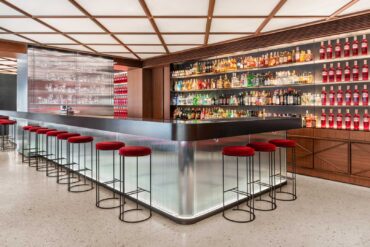Aphra Behn (1640–1689), British, knew a thing or two about keeping secrets. By the age of 25, she had already been recruited as a spy for King Charles II. The setting is as murky as it gets: Britain is caught in the throes of the Second Anglo-Dutch War, and someone needs to travel to Antwerp to enlist double agents. Behn accepts the mission, reaches the city — and is betrayed. Sold out to the Dutch, she manages to save herself, but returns home mired in debt.
To make matters worse, her husband dies and the king decides not to pay her for her clandestine services. So Behn turns to the pen. She reinvents herself as a translator, poet, novelist and playwright, signing her works with the pseudonym Astrea — the same code name she had used in espionage.
Tracing a Classic Cocktail Back to Aphra Behn
She becomes one of the first English women to earn a living from her writing alone. But literature wasn’t her only claim to fame: London’s high society soon knew her as the hostess of legendary soirées, where the Milk Punch flowed freely. It’s worth recalling a few details. First, the punch served in Behn’s day was notoriously potent, and it was always poured into bowls, never individual glasses. We also know her recipe called for brandy, lemon juice and milk. Clarification techniques were already practiced at the time, and it’s likely that Behn’s punch was strained to achieve a crystalline texture. Whatever the process, her concoction became the stuff of legend. Guests raved about it, and her gatherings became social milestones in Restoration London.
The Milk Punch Recipe

Yet the exact formula remains a mystery. Drinking customs evolved over the centuries, and the communal punch bowl eventually gave way to single-serve cocktails — smoother, silkier, and easier to tame. By the time Jerry Thomas published his “Bartender’s Guide” in 1862, Aphra Behn’s original recipe had vanished into history. All that’s left are the fragments handed down by the Professor.
Ingredients
- 1 Teaspoon of Superfine White Sugar
- 2 Teaspoons of Water
- 60 ml of Cognac
- 30 ml of Rum
- Milk, to top
Method
Take a tumbler and fill it one-third of the way with crushed ice. Pour in the ingredients, then top up with milk. Seal the glass with the metal tin of a shaker and give it a vigorous shake.
Garnish
Finish with a light grating of nutmeg on top, then slip in a straw.
The article first appeared on Coqtail – for fine drinkers. Order your copy here
Images credits Julie Couder, location Mag La Pusterla







